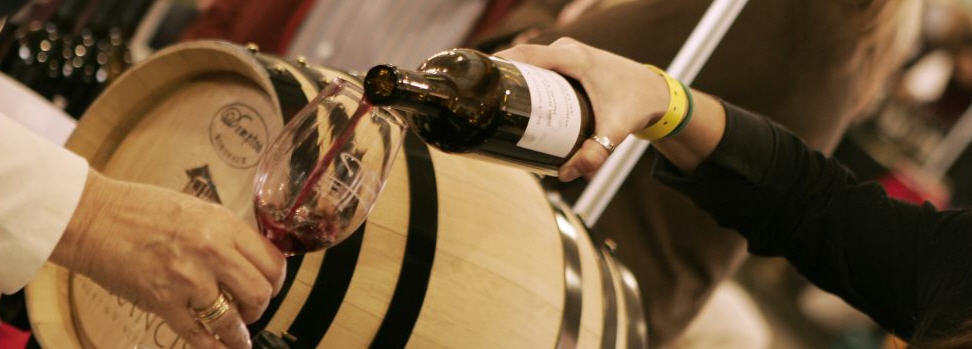I recently learned about ZAP events in the Bay Area although they don’t stop there. ZAP produces numerous events, tours, cruises and partners with many of the wine industry’s leading organizations. They also produce the world’s largest Zinfandel Festival with up to 300 wineries pouring the latest Zinfandel releases.
This week in San Francisco, they are hosting Epicuria, which is a Food & Zin Pairings event, a culinary adventure where 50 top Zinfandel wines and wineries collaborate with 50 chefs. From boar to molecular wine ice cream (yes, really), Epicuria is one of four events making up Zinfandel Advocates & Producers’ 22nd Annual Zinfandel Festival in San Francisco.
Imagine making Muleheart Farm Pork Chili (from Central Market) or Braised Pork Belly Bahn Mi Sandwich (from the Ledson Hotel) while sampling some of the best Zinfandels along the way?
These are some of the recipes being presented at Epicuria. A few teams participating include Barefoot Cellars with Sonoma Cake Creations, Dogwood Cellars with Sift Cupcake Frank Family Vineyards with Chef Tyler Stone (Frank Family Molecular Wine Ice Cream Dessert), Grgich Hills Estate with 3D Candies (Raspberry Hazelnut Caramel and Lavender Black Cherry Vanilla Caramel) and Scott Harvey Wines with Healdsburg Toffee (Assorted candies).
Several teams are offering non-traditional combos—namely Klinker Brick Winery with Radius (Duck Liver Mousse with Blackberry Gastrique), Gnarly Head Winery with Johnny Garlic’s (Sashimi Won Tacos), Peachy Canyon Winery with Swan Oyster Depot (Shrimp Cocktail), and Renwood Winery with Eastside West Restaurant (Achiote Braised Lamb – mango & olive salad, cheese fried plantains, mint, cilantro).
They are also doing a Zinfandel Winemakers’ Dinner at The Fairmont Hotel on Friday, February 1, a glamorous evening where a walkaround tasting precedes a live auction and sumptuous dinner. The proceeds benefit ZAP’s programming, education and heritage vineyard projects.
The concluding event is the Grand Tasting on Saturday, February 2, which is the world’s largest single varietal tasting, a chance to taste more than 200 different Zinfandels.
Check out We Blog the World’s Food & Wine Events in North America for more fun suggestions and discoveries. Below find a little history on Zinfandel in the United States. (taken from the Zinfandel.org site, which has a host of useful information including details on the Zinfandel Festival itself).
Zinfandel’s U.S. Roots:
“Historians have traced Zinfandel’s roots in the United States back to the 1820s, when cuttings from the Imperial collection of plant species in Vienna, Austria, were imported. By 1832, a Boston nursery was advertising “Zinfendal” vines for sale, and sometime between 1835 and 1845 “Zinfandel” had become a popular grape in the Northeastern United States. Later, vines were transported west during the Gold Rush of the 1840s, where production surged because the grapes could be easily cultivated using the traditional European “head pruning” technique, requiring no special equipment or scarce resources like wire and timber. Zinfandel’s appeal soared during this time because it grew vigorously and provided miners with a versatile, substantial beverage.
Zinfandel’s expansion in the 20th century is a testament to its hardy constitution. While most of California’s vineyards were destroyed by phylloxera in the late 1800s, Zinfandel vines were among the first vines replanted on rootstock starting around 1885. By mid-century it had become the most important varietal among California red table wines. The wave of blush wines in the 1970s began when California wineries began to draw free-run juice from Zinfandel grapes, fermenting it as “white” Zinfandel. This started a trend that led to the preservation of old Zinfandel vines, which may otherwise have been lost through grafting over to other varietals at a time when red table wines waned in popularity.
The 1990s brought a focus on research and the involvement of Zinfandel enthusiasts in a movement to celebrate and promote the varietal. By the end of the decade, Zinfandel had become competitive in the world market, proving to an international audience that America could produce fine red table wines comparable to their European counterparts.”

Renee Blodgett is the founder of We Blog the World. The site combines the magic of an online culture and travel magazine with a global blog network and has contributors from every continent in the world. Having lived in 10 countries and explored nearly 80, she is an avid traveler, and a lover, observer and participant in cultural diversity.
She is also the CEO and founder of Magic Sauce Media, a new media services consultancy focused on viral marketing, social media, branding, events and PR. For over 20 years, she has helped companies from 12 countries get traction in the market. Known for her global and organic approach to product and corporate launches, Renee practices what she pitches and as an active user of social media, she helps clients navigate digital waters from around the world. Renee has been blogging for over 16 years and regularly writes on her personal blog Down the Avenue, Huffington Post, BlogHer, We Blog the World and other sites. She was ranked #12 Social Media Influencer by Forbes Magazine and is listed as a new media influencer and game changer on various sites and books on the new media revolution. In 2013, she was listed as the 6th most influential woman in social media by Forbes Magazine on a Top 20 List.
Her passion for art, storytelling and photography led to the launch of Magic Sauce Photography, which is a visual extension of her writing, the result of which has led to producing six photo books: Galapagos Islands, London, South Africa, Rome, Urbanization and Ecuador.
Renee is also the co-founder of Traveling Geeks, an initiative that brings entrepreneurs, thought leaders, bloggers, creators, curators and influencers to other countries to share and learn from peers, governments, corporations, and the general public in order to educate, share, evaluate, and promote innovative technologies.









